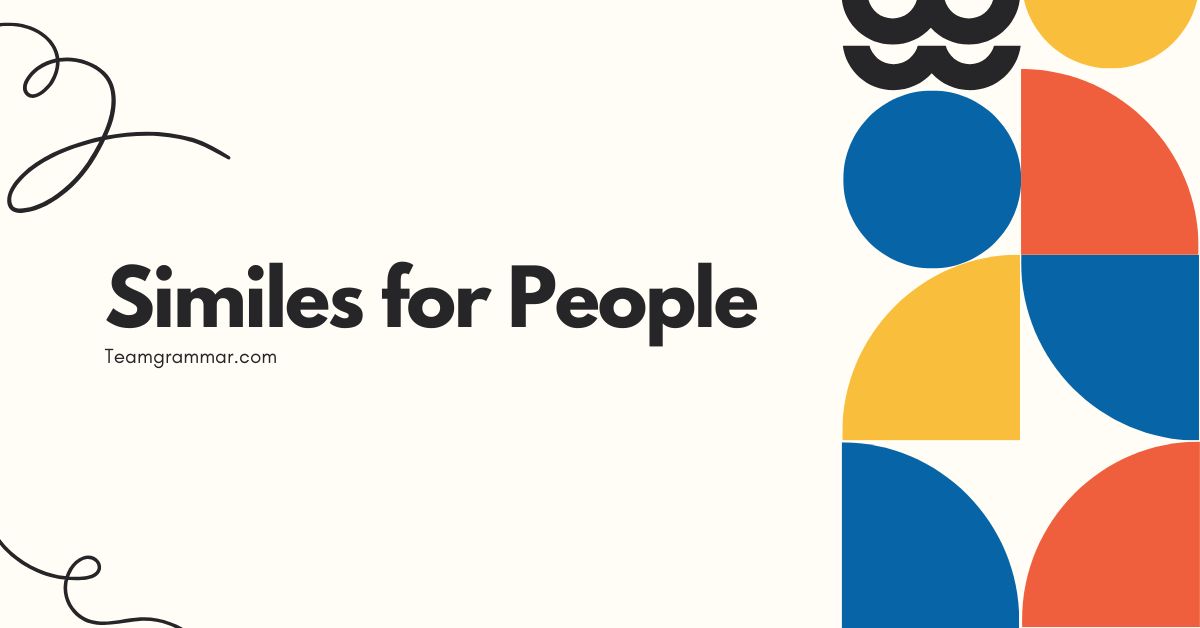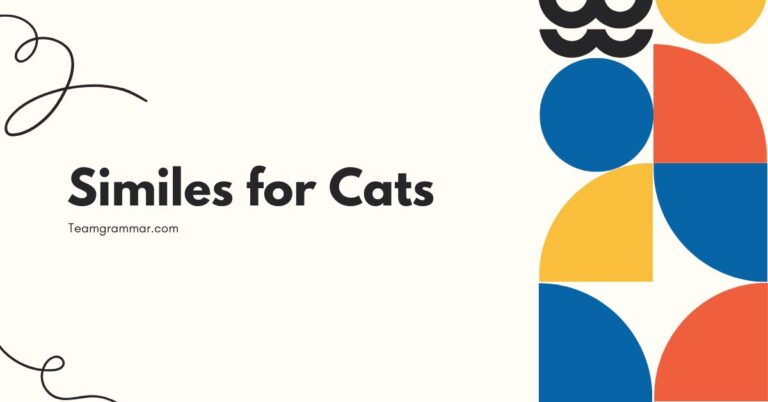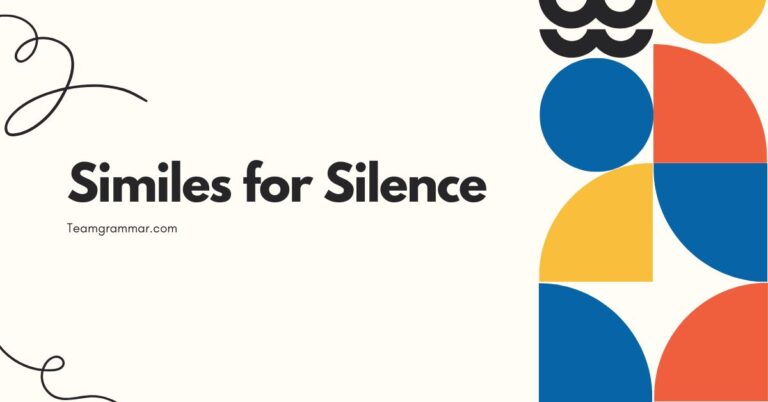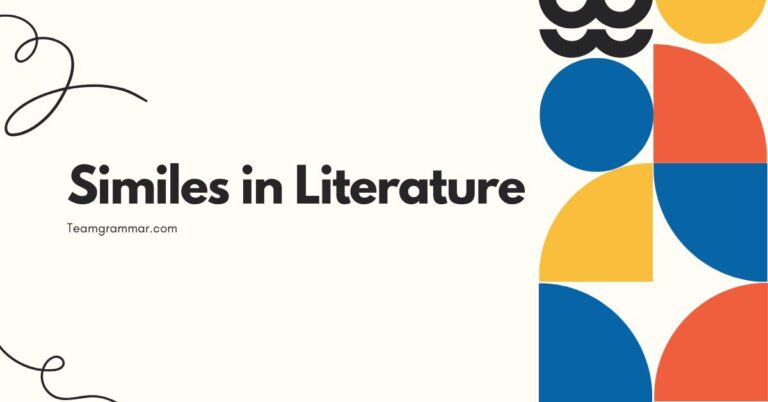31 Similes for People: Mastering Figurative Language
Similes are powerful tools that enrich our language, allowing us to paint vivid pictures and draw meaningful comparisons. Understanding how to effectively use similes, especially when describing people, can significantly enhance your writing and communication skills.
This article provides a comprehensive guide to using similes for people, covering everything from basic definitions to advanced techniques, making it ideal for English language learners, writers, and anyone looking to improve their descriptive abilities.
Table of Contents
- Introduction
- Definition of Similes
- Structural Breakdown of Similes
- Types of Similes for People
- Examples of Similes for People
- Usage Rules for Similes
- Common Mistakes with Similes
- Practice Exercises
- Advanced Topics in Similes
- Frequently Asked Questions
- Conclusion
Introduction
Similes are an essential part of figurative language, adding color and depth to our descriptions. When used effectively, they can transform bland statements into engaging and memorable expressions.
This article focuses specifically on similes used to describe people, exploring how they can capture personality traits, physical appearances, and emotional states. Whether you’re a student learning the basics of English grammar or a seasoned writer looking to refine your craft, this guide will provide you with the knowledge and tools you need to master the art of using similes for people.
By the end of this article, you will understand the structure of similes, recognize different types, and be able to create your own compelling comparisons. We will explore numerous examples, discuss common mistakes to avoid, and provide practice exercises to solidify your understanding.
This comprehensive approach ensures that you not only grasp the theoretical concepts but also develop the practical skills necessary to use similes effectively in your writing and speech.
Definition of Similes
A simile is a figure of speech that directly compares two different things using the words “like” or “as.” The purpose of a simile is to create a vivid image or convey a deeper understanding by highlighting the similarities between the two compared items. Similes are a type of metaphor, but unlike metaphors, they explicitly state the comparison using “like” or “as.”
Classification of Similes
Similes fall under the broader category of figurative language, which includes metaphors, personification, hyperbole, and more. They are specifically classified as direct comparisons because they clearly indicate the relationship between the two things being compared.
This directness distinguishes them from metaphors, which imply the comparison without explicitly stating it.
Function of Similes
The primary function of a simile is to enhance understanding and create a more impactful image in the reader’s or listener’s mind. By drawing a comparison to something familiar, similes can make abstract concepts more concrete and relatable.
They also add stylistic flair to writing, making it more engaging and memorable. When used to describe people, similes can effectively convey personality traits, physical attributes, or emotional states in a concise and evocative manner.
Contexts for Using Similes
Similes are appropriate in a wide range of contexts, from creative writing and poetry to everyday conversation and professional presentations. In literature, they are often used to add depth and texture to character descriptions and scene settings.
In everyday speech, similes can help to clarify explanations and make conversations more interesting. In professional settings, similes can be used to simplify complex ideas and make presentations more engaging.
Structural Breakdown of Similes
Understanding the structure of a simile is crucial for creating effective and meaningful comparisons. A typical simile consists of three main components: the subject (the thing being described), the comparative word (“like” or “as”), and the object of comparison (the thing it is being compared to).
The Subject
The subject is the person or thing that you are trying to describe. It is the focal point of the simile and the element that you want to illuminate through comparison.
For example, in the simile “He is as brave as a lion,” the subject is “He.”
The Comparative Word
The comparative word is the link that connects the subject and the object of comparison. The most common comparative words are “like” and “as.” These words explicitly indicate that a comparison is being made.
For example, “She sings like an angel” uses “like” to draw a comparison between her singing and the singing of an angel.
The Object of Comparison
The object of comparison is the person, thing, or concept to which the subject is being compared. It should have a characteristic that is similar to the subject, allowing for a meaningful comparison.
In the simile “He is as strong as an ox,” the object of comparison is “an ox,” which is known for its strength.
Common Patterns and Rules
Similes often follow specific patterns to create effective comparisons. One common pattern is: Subject + is/are + as/like + adjective + as/like + object of comparison.
For example, “She is as graceful as a swan.” Another pattern is: Subject + verb + like/as + object of comparison + verb. For example, “He runs like the wind.” Understanding these patterns can help you construct clear and impactful similes.
Types of Similes for People
Similes can be categorized based on the type of comparison they make, such as comparisons of appearance, behavior, or emotional state. Understanding these categories can help you choose the most appropriate simile for your descriptive needs.
Similes Describing Appearance
These similes focus on physical attributes, such as height, weight, hair color, or complexion. They help to create a visual image of the person being described.
For example, “She is as tall as a giraffe” or “His skin is like alabaster.”
Similes Describing Behavior
These similes compare a person’s actions or habits to those of another person, animal, or thing. They help to convey personality traits and characteristic behaviors.
For example, “He eats like a horse” or “She works like a beaver.”
Similes Describing Emotional State
These similes express a person’s feelings or mood by comparing them to something that evokes a similar emotion. They help to convey the intensity and nature of the person’s emotional state.
For example, “He was as angry as a hornet” or “She felt like a wilted flower.”
Similes Describing Skill and Ability
These similes highlight a person’s talents or capabilities by comparing them to someone or something known for that skill. For example, “He sings like an angel” or “She dances like a professional.”
Examples of Similes for People
The following tables provide extensive examples of similes used to describe people, categorized by the type of comparison they make. These examples illustrate the versatility and effectiveness of similes in conveying different aspects of a person’s character, appearance, and behavior.
Appearance Similes Examples
This table showcases similes that describe a person’s physical attributes, such as their height, weight, complexion, and features. These similes help to create a vivid visual image of the person being described.
| Simile | Explanation |
|---|---|
| She is as tall as a giraffe. | Describes someone who is very tall. |
| He is as thin as a rail. | Describes someone who is very skinny. |
| Her skin is like alabaster. | Describes someone with very pale and smooth skin. |
| His eyes are like deep blue seas. | Describes someone with captivating blue eyes. |
| She is as radiant as the sun. | Describes someone with a bright and glowing appearance. |
| He is built like a brick house. | Describes someone who is strong and sturdy. |
| Her hair is like spun gold. | Describes someone with beautiful, golden hair. |
| His beard is as white as snow. | Describes someone with a very white beard. |
| She is as delicate as a flower. | Describes someone who is fragile and graceful. |
| He is as round as a ball. | Describes someone who is overweight. |
| Her smile is like sunshine. | Describes someone with a warm and cheerful smile. |
| His hands are as rough as sandpaper. | Describes someone with calloused hands. |
| She moves like a gazelle. | Describes someone who is graceful and agile. |
| He is as imposing as a mountain. | Describes someone who has a strong and commanding presence. |
| Her voice is like velvet. | Describes someone with a smooth and pleasant voice. |
| His face is as pale as a ghost. | Describes someone who looks very pale, often from fear or illness. |
| She is as luminous as the moon. | Describes someone with a radiant and ethereal beauty. |
| He is as solid as an oak. | Describes someone who is strong and reliable. |
| Her figure is like an hourglass. | Describes someone with a classic, curvy figure. |
| His gaze is as sharp as a hawk’s. | Describes someone with an intense and perceptive gaze. |
| She’s as bright as a button. | Describes someone with a cheerful and lively appearance. |
| He’s as broad as a barn door. | Describes someone with a large and imposing physique. |
| Her complexion is like porcelain. | Describes someone with a flawless and pale complexion. |
| His features are as chiseled as a statue. | Describes someone with well-defined and attractive features. |
| She’s as slender as a willow. | Describes someone who is gracefully thin and flexible. |
Behavior Similes Examples
This table presents similes that compare a person’s actions, habits, or personality traits to those of animals, objects, or other people. These similes help to convey a deeper understanding of the person’s character.
| Simile | Explanation |
|---|---|
| He eats like a horse. | Describes someone who eats a lot. |
| She works like a beaver. | Describes someone who is very hardworking. |
| He sleeps like a log. | Describes someone who sleeps very soundly. |
| She gossips like a magpie. | Describes someone who talks a lot about other people. |
| He is as stubborn as a mule. | Describes someone who is very obstinate. |
| She is as quiet as a mouse. | Describes someone who is very quiet and timid. |
| He follows orders like a robot. | Describes someone who obeys instructions without question. |
| She argues like a lawyer. | Describes someone who is skilled at debate and persuasion. |
| He spends money like water. | Describes someone who spends money wastefully. |
| She sings like a nightingale. | Describes someone who sings beautifully. |
| He fights like a tiger. | Describes someone who fights fiercely. |
| She dances like a swan. | Describes someone who dances gracefully. |
| He runs like the wind. | Describes someone who runs very fast. |
| She watches like a hawk. | Describes someone who is very observant. |
| He leads like a general. | Describes someone who leads with authority and strategy. |
| She plans like an architect. | Describes someone who plans meticulously and thoughtfully. |
| He learns like a sponge. | Describes someone who absorbs information quickly and easily. |
| She remembers like an elephant. | Describes someone with a very good memory. |
| He avoids responsibility like the plague. | Describes someone who actively avoids taking responsibility. |
| She organizes like a librarian. | Describes someone who is very organized and methodical. |
| He negotiates like a seasoned diplomat. | Describes someone who is skilled at negotiating and diplomacy. |
| She adapts like a chameleon. | Describes someone who can easily adjust to different situations. |
| He persists like a bulldog. | Describes someone who is tenacious and determined. |
| She anticipates like a chess master. | Describes someone who can foresee and prepare for future events. |
| He procrastinates like a professional. | Describes someone who is skilled at delaying tasks. |
Emotional State Similes Examples
This table provides examples of similes that express a person’s feelings or mood by comparing them to things that evoke similar emotions. These similes help to convey the intensity and nature of the person’s emotional state.
| Simile | Explanation |
|---|---|
| He was as angry as a hornet. | Describes someone who is very angry. |
| She felt like a wilted flower. | Describes someone who feels sad and drained. |
| He was as happy as a clam. | Describes someone who is very happy and content. |
| She felt like she was walking on air. | Describes someone who feels elated and joyful. |
| He was as nervous as a long-tailed cat in a room full of rocking chairs. | Describes someone who is very nervous and anxious. |
| She felt like she had been hit by a truck. | Describes someone who feels overwhelmed and exhausted. |
| He was as calm as a still lake. | Describes someone who is very peaceful and serene. |
| She felt like she was floating on a cloud. | Describes someone who feels carefree and relaxed. |
| He was as excited as a kid in a candy store. | Describes someone who is very excited and enthusiastic. |
| She felt like she had won the lottery. | Describes someone who feels extremely fortunate and happy. |
| He was as lonely as a scarecrow. | Describes someone who feels very isolated and alone. |
| She felt like she was drowning in sorrow. | Describes someone who feels overwhelmed by sadness. |
| He was as scared as a rabbit caught in headlights. | Describes someone who is very frightened. |
| She felt like she was trapped in a cage. | Describes someone who feels confined and restricted. |
| He was as surprised as a deer in headlights. | Describes someone who is very surprised and startled. |
| She felt like she had been betrayed. | Describes someone who feels deeply hurt by someone they trusted. |
| He was as frustrated as a computer with a virus. | Describes someone who is very annoyed and irritated. |
| She felt like she was losing her mind. | Describes someone who feels confused and overwhelmed. |
| He was as relieved as a prisoner set free. | Describes someone who feels a great sense of relief. |
| She felt like she had been rescued. | Describes someone who feels grateful for being saved from a difficult situation. |
| He was as proud as a peacock. | Describes someone who is very proud and boastful. |
| She felt like she was on top of the world. | Describes someone who feels successful and triumphant. |
| He was as jealous as a rival in love. | Describes someone who is very envious and possessive. |
| She felt like she had been stabbed in the back. | Describes someone who feels betrayed and hurt by someone close to them. |
Skill and Ability Similes Examples
The following table provides similes which describe a person’s skills or abilities by comparing them to someone or something with similar talents.
| Simile | Explanation |
|---|---|
| He sings like an angel. | Describes someone who sings beautifully. |
| She dances like a professional. | Describes someone who dances with great skill. |
| He paints like a master. | Describes someone who paints with exceptional skill. |
| She writes like a poet. | Describes someone who writes beautifully and creatively. |
| He plays the piano like a virtuoso. | Describes someone who plays the piano with outstanding skill and artistry. |
| She cooks like a chef. | Describes someone who cooks with great expertise. |
| He leads like a general. | Describes someone who leads with authority and strategy. |
| She teaches like a sage. | Describes someone who teaches with wisdom and insight. |
| He negotiates like a diplomat. | Describes someone who negotiates skillfully and tactfully. |
| She organizes like a librarian. | Describes someone who is very organized and methodical. |
| He solves problems like a detective. | Describes someone who is adept at finding solutions to complex issues. |
| She designs like an architect. | Describes someone who designs with creativity and precision. |
| He repairs things like an engineer. | Describes someone who is skilled at fixing and maintaining equipment. |
| She manages projects like a CEO. | Describes someone who manages projects with efficiency and expertise. |
| He speaks like an orator. | Describes someone who speaks eloquently and persuasively. |
| She analyzes data like a statistician. | Describes someone who is skilled at interpreting and analyzing data. |
| He codes like a programmer. | Describes someone who is proficient at writing computer code. |
| She innovates like an inventor. | Describes someone who is creative and resourceful in developing new ideas. |
| He strategizes like a chess master. | Describes someone who plans ahead and anticipates future moves. |
| She performs like an actress. | Describes someone who acts with skill and charisma. |
| He researches like a scientist. | Describes someone who conducts research thoroughly and methodically. |
| She mentors like a guru. | Describes someone who guides and supports others with wisdom and experience. |
| He sells like a top salesman. | Describes someone who is highly effective at selling products or services. |
| She writes code like a seasoned developer. | Describes someone who writes computer code with great skill and efficiency. |
Usage Rules for Similes
Using similes effectively requires understanding the rules that govern their proper use. These rules ensure that your comparisons are clear, meaningful, and appropriate for the context.
Clarity and Relevance
A good simile should be clear and easy to understand. The comparison should be relevant and highlight a specific similarity between the subject and the object of comparison.
Avoid using obscure or overly complex comparisons that may confuse the reader.
Originality and Freshness
While some common similes can be effective, try to create original comparisons that are fresh and engaging. Overused similes can become clichéd and lose their impact.
Strive to find unique and creative ways to describe people and their characteristics.
Contextual Appropriateness
Consider the context in which you are using the simile. The comparison should be appropriate for the tone and style of your writing or speech.
Avoid using similes that are offensive, insensitive, or out of place in the given context.
Grammatical Correctness
Ensure that your similes are grammatically correct. The subject and object of comparison should be properly connected using “like” or “as,” and the sentence structure should be clear and logical.
Pay attention to verb tense and subject-verb agreement.
Avoiding Mixed Metaphors
Be careful to avoid mixed metaphors, which occur when you combine two or more incompatible metaphors or similes in the same sentence. This can create a confusing and nonsensical image.
For example, “He was as brave as a lion, but he was also a chicken at heart” is a mixed metaphor because it combines two contradictory images.
Common Mistakes with Similes
Even experienced writers can make mistakes when using similes. Understanding these common errors can help you avoid them and improve the effectiveness of your comparisons.
Using Cliches
Incorrect: He was as busy as a bee.
Correct: He was as busy as a conductor orchestrating a symphony.
Explanation: Cliches are overused and lack originality. Replacing them with fresh comparisons makes your writing more engaging.
Making Illogical Comparisons
Incorrect: She is as tall as a tree, but she can’t reach the top shelf.
Correct: She is as tall as a basketball player.
Explanation: Ensure the comparison makes sense. If someone is as tall as a tree, they should logically be able to reach a top shelf.
Overusing Similes
Incorrect:He was as strong as an ox. His voice was like thunder.
His eyes were as sharp as a hawk.
Correct: He was incredibly strong, his voice boomed, and his eyes missed nothing.
Explanation: Too many similes can clutter your writing. Use them sparingly to maintain impact.
Misusing “Like” and “As”
Incorrect: She sings as an angel.
Correct: She sings like an angel.
Explanation: “Like” is used to compare nouns or pronouns, while “as” can be used as a conjunction. In this case, “like” is the correct choice.
Using an Inappropriate Tone
Incorrect: Describing a somber event: “He was as happy as a clown.”
Correct: Describing a somber event: “He was as despondent as a prisoner awaiting trial.”
Explanation: Ensure the simile matches the tone of the piece. A happy simile is inappropriate for a sad or serious context.
Practice Exercises
Test your understanding of similes with these practice exercises. Choose the best simile to complete each sentence, or create your own simile to describe the given person or situation.
Exercise 1: Completing Similes
Complete the following sentences by choosing the best simile from the options provided.
| Question | Options | Answer |
|---|---|---|
| 1. He was as brave as ______. | a) a kitten, b) a lion, c) a mouse | b) a lion |
| 2. She sings like ______. | a) a frog, b) a crow, c) a nightingale | c) a nightingale |
| 3. He is as stubborn as ______. | a) a feather, b) a mule, c) a cloud | b) a mule |
| 4. She works like ______. | a) a sloth, b) a turtle, c) a beaver | c) a beaver |
| 5. He sleeps like ______. | a) a log, b) a bird, c) a baby | a) a log |
| 6. She gossips like ______. | a) a whisper, b) a magpie, c) a secret | b) a magpie |
| 7. He is as quiet as ______. | a) a drum, b) a mouse, c) a bell | b) a mouse |
| 8. She felt like ______. | a) a queen, b) a jester, c) a clown | a) a queen |
| 9. He runs like ______. | a) a snail, b) a cheetah, c) a turtle | b) a cheetah |
| 10. She watches like ______. | a) a hawk, b) a cat, c) a dog | a) a hawk |
Exercise 2: Creating Similes
Create your own similes to describe the following people or situations.
| Description | Your Simile |
|---|---|
| 1. A very energetic child | Like a jumping bean. |
| 2. A calm and peaceful person | As calm as a still pond. |
| 3. A very intelligent student | Like a walking encyclopedia. |
| 4. A messy room | Like a disaster zone. |
| 5. A difficult task | As challenging as climbing Mount Everest. |
| 6. A boring speech | Like watching paint dry. |
| 7. A delicious meal | Like a taste of heaven. |
| 8. A frightening experience | As scary as a horror movie. |
| 9. A relaxing vacation | Like floating on a cloud. |
| 10. A surprising event | As unexpected as a snowstorm in July. |
Advanced Topics in Similes
For advanced learners, exploring more complex aspects of similes can further enhance their understanding and usage. These topics include extended similes, metaphorical similes, and the use of similes in literary analysis.
Extended Similes
An extended simile is a simile that is developed over several lines or sentences, providing a more detailed and elaborate comparison. This technique allows for a deeper exploration of the similarities between the subject and the object of comparison, creating a more vivid and memorable image.
Metaphorical Similes
A metaphorical simile combines elements of both simile and metaphor, using “like” or “as” to draw a comparison that also has a symbolic or figurative meaning. This type of simile adds layers of complexity and depth to the comparison, inviting the reader to interpret the underlying symbolism.
Similes in Literary Analysis
Analyzing the use of similes in literature can provide valuable insights into the author’s style, themes, and character development. By examining the types of comparisons used and their effect on the reader, you can gain a deeper appreciation for the artistry of the text.
Consider the context of the simile, the emotions it evokes, and the overall impact it has on the meaning of the work.
Frequently Asked Questions
Here are some frequently asked questions about similes, along with detailed answers to help clarify any remaining points.
- What is the difference between a simile and a metaphor?
A simile is a direct comparison using “like” or “as,” while a metaphor is an implied comparison that states one thing is another. For example, “He is like a lion” is a simile, whereas “He is a lion” is a metaphor. Similes are more explicit, while metaphors are more suggestive.
- Can a simile be considered a cliché?
Yes, a simile can become a cliché if it is overused and lacks originality. Common examples include “as busy as a bee” or “as strong as an ox.” To avoid clichés, try to create fresh and unique comparisons that are specific to the context.
- How do I choose the right object of comparison for a simile?
Choose an object of comparison that shares a relevant characteristic with the subject you are describing. The comparison should be clear, logical, and appropriate for the context. Consider the emotions and associations that the object of comparison evokes.
- Is it possible to overuse similes in writing?
Yes, overusing similes can make your writing seem cluttered and forced. Use similes sparingly and strategically to enhance your descriptions, rather than relying on them as a crutch.
- What is an extended simile, and how is it used?
An extended simile is a simile that is developed over several lines or sentences, providing a more detailed and elaborate comparison. This technique allows for a deeper exploration of the similarities between the subject and the object of comparison, creating a more vivid and memorable image. Extended similes are often used in poetry and prose to add depth and texture to the writing.
- How can similes be used to enhance character development in fiction?
Similes can be used to reveal a character’s personality traits, physical attributes, and emotional state in a concise and evocative manner. By comparing a character to something familiar, you can create a more impactful image in the reader’s mind and help them understand the character on a deeper level.
- What are some examples of similes that describe personality traits?
Some examples of similes that describe personality traits include: “He is as stubborn as a mule,” “She is as quiet as a mouse,” “He is as brave as a lion,” and “She is as clever as a fox.” These similes use familiar objects or animals to convey specific personality traits.
- How do I avoid making illogical comparisons in my similes?
To avoid making illogical comparisons, ensure that the subject and object of comparison share a clear and relevant similarity. The comparison should make sense in the given context and should not create a confusing or nonsensical image. Double-check your similes to ensure they are logically sound.
- Are similes appropriate for formal writing or should they be limited to creative writing?
While similes are commonly used in creative writing to add flair and imagery, they can also be appropriate in formal writing when used judiciously to clarify complex concepts or make explanations more engaging. The key is to use similes that are clear, relevant, and appropriate for the tone and style of the writing.
Conclusion
Mastering the art of using similes for people can significantly enhance your writing and communication skills. By understanding the structure of similes, recognizing different types, and avoiding common mistakes, you can create
create compelling comparisons that bring your descriptions to life.
Whether you’re describing physical appearances, behavioral traits, or emotional states, similes offer a powerful tool for adding depth, color, and clarity to your language. Practice the techniques discussed in this article, and you’ll be well on your way to becoming a master of figurative language.







